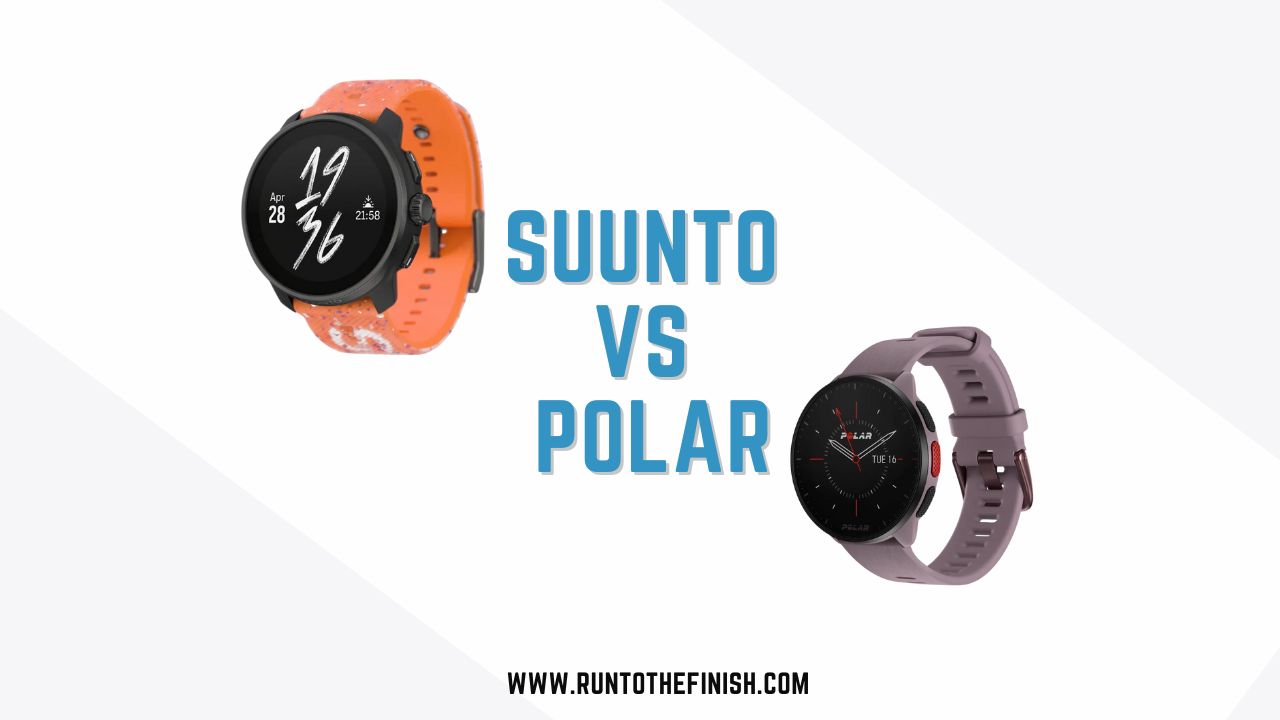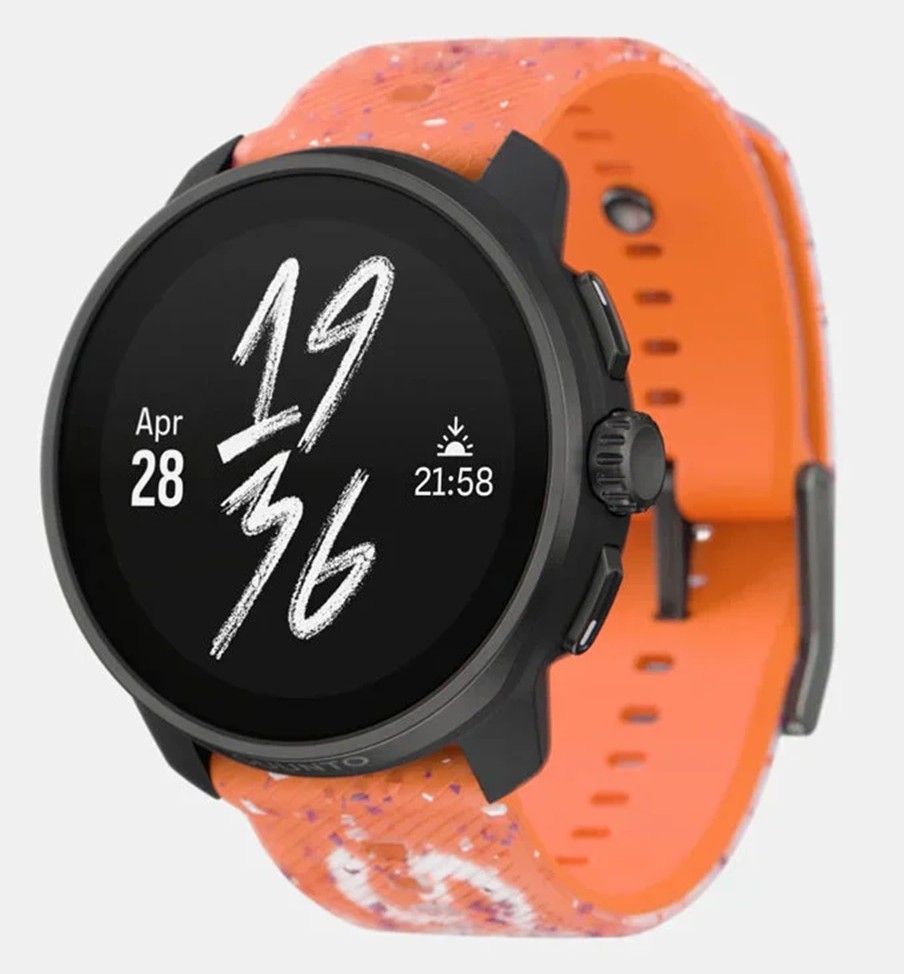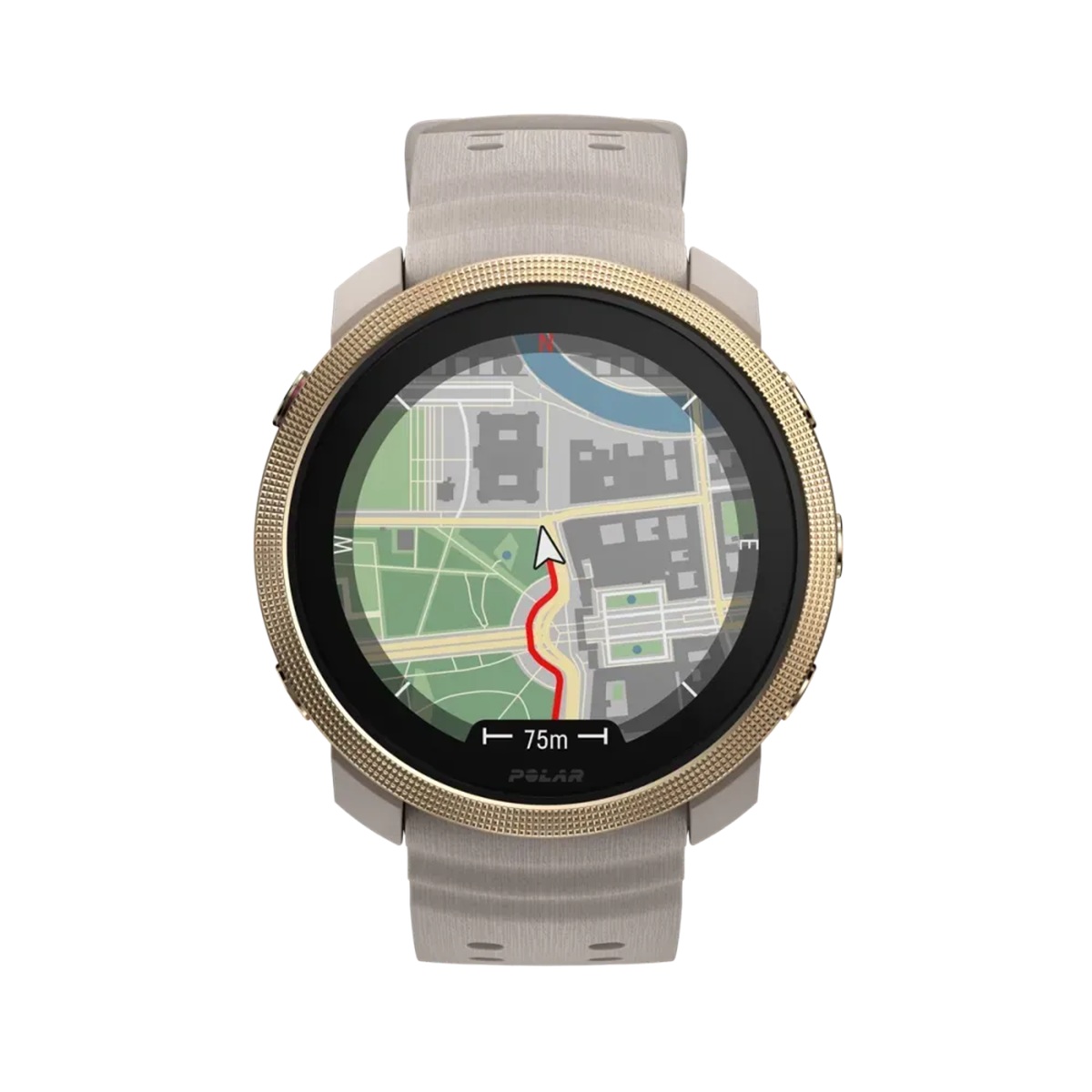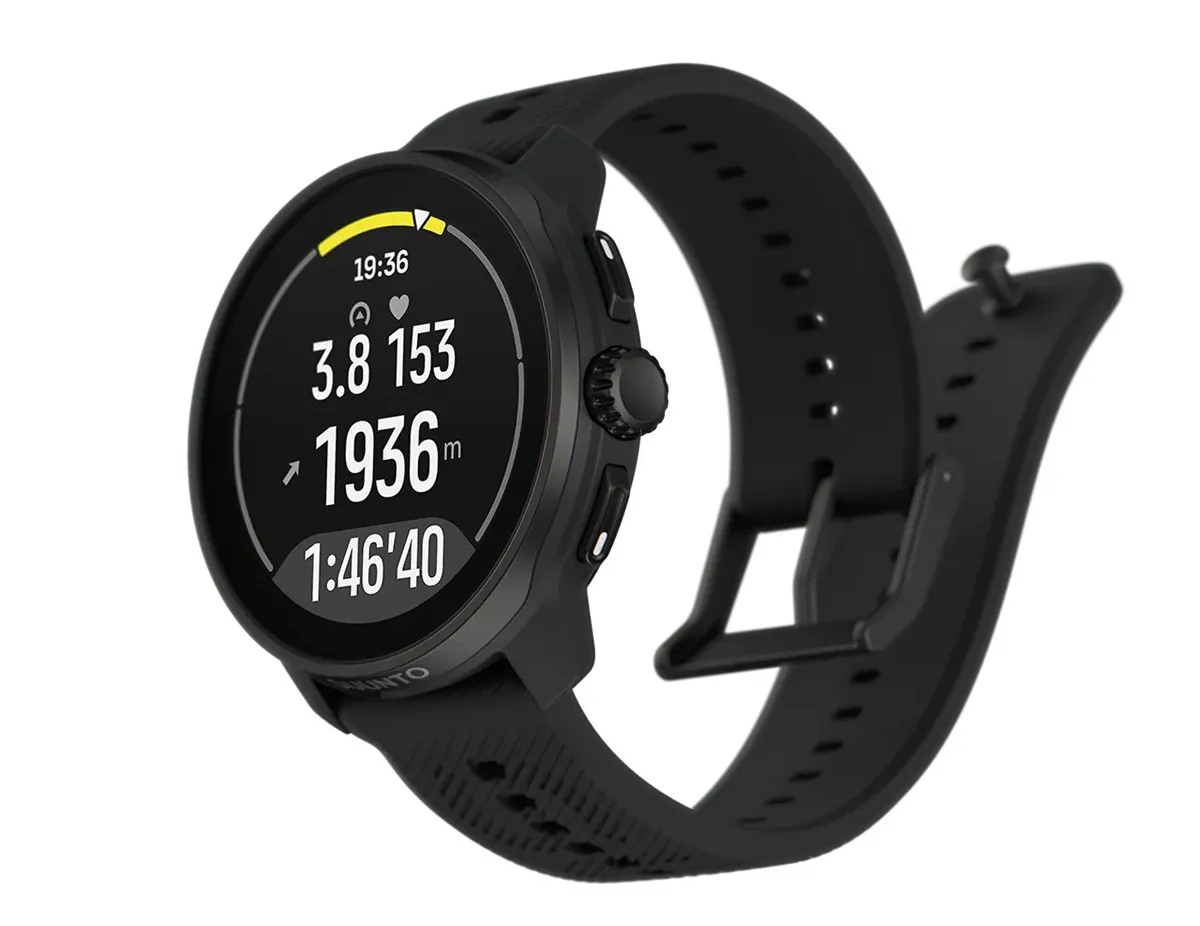Finding the right GPS watch is worth a little research time because it’s a high ticket piece of gear and you want it meet your needs! Let’s look at Suunto vs Polar fitness watches to see how they stack up.

A few key differences in Suunto vs Polar:
- Suunto feels like it wants to be the for rugged gritty individual. Google integrations make it more Android like.
- Polar is focused on enhancing the details of your training – most accurate HR, GPS.
If you’re looking to purchase your first GPS watch for running, check out my post on GPS watch mistakes not to make, so you don’t end up getting more than what you need and spending more money than necessary.
This side-by-side comparison should help you better understand the different features and narrow down your choices.
Polar VS Suunto For Running
Let’s look at watches from low end to high end by both brands. You’ll be be able to see how they match up and what might best meet your running needs.
Budget Running Watches
I struggle a bit to put these in the same category because it feels like Suunto has quite a bit more included. The Polar Pacer is truly designed to be that scaled back entry level watch.
Polar Pacer vs Suunto Race S
- Polar Pacer max battery life 35 hours, Suunto Race S GPS battery life up to 30 hours
- Suunto includes Altimeter and maps
- Polar has 3 satellite options, Suunto has 5
- Polar weights 40g and Suunto heavier at 60g
- Both watches can be used for swimming
- Both offer HR monitoring and sleep monitoring
- Both track Distance, Calories Burned, Activity, Sleep, Heart Rate, Steps, Activity Speed, Time
Polar Pacer ($199)
This is now what’s considered an entry level running watch and it has EVERYTHING including smart watch features. No need to overspend to just get the basic data you need to run.
- Not Touchscreen
- 6 days Smartwatch mode
- 155 hours training mode
- No wrist mapping but you can follow a route and use back-to-start
- Available in 3 colors
For $100 more you can get the Polar Pacer Pro. Check our full review of the Polar Pacer Pro here >>

See my full review of the Polar Pacer Pro (the upgraded entry level) >>
Suunto Race S ($350)
Having removed many previous models at a budget friendly cost this is now their entry level watch and it includes EVERYTHING you could possibly need, especially as a trail runner. We know it’s still a higher price point but it seems that Suunto is truly phasing out their older models, even on websites like REI and Amazon.
Features include basic functions + altitude measurement, route navigation and track back, interval workout planner, running cadence, and activity-based recovery time. I say during my testing, I found the HR monitor to be very unreliable.
- Touchscreen
- 13 days Smartwatch mode
- 30 hours Performance mode, 120 hours Tour mode
- Wrist mapping
- Available in 7 (!!) colors

Midrange Running Watches
Polar Vantage M3 vs Suunto Race
The differences start to become more apparent here.
- Suunto Race max GPS battery life 30 hours, Polar M3 GPS battery life 30 hours
- Suunto Race is slightly heavier at 83 grams to 53 grams Polar
- Suunto provides a superior map experience
- Both watches can be used for swimming and a multitude of other sports
- Both track Distance, Calories Burned, Activity, Sleep, Heart Rate, Steps, Activity Speed, Time
Polar Vantage M3 ($399)
Polar designed this watch for multi-sport athletes who love diving into data and are looking for tools to help them improve their performance. Basically if you are an athlete that loves having all the bells and whistles at your fingertips, this watch would be a great fit!
This watch will track running, swimming, and cycling and tell you your ground contact time balance, stride length, and more.
- Touchscreen
- 7 days Smartwatch mode
- 30 hours Performance training mode
- No wrist mapping but you can follow a route and use back-to-start
- Available in 2 colors

See our full review of the Polar Vantage M3 here >>
Suunto Race ($399)
The Suunto Race is packed with features designed for athletes who want to dive into the details—think advanced metrics, recovery insights, and even race preparation tools.
For seasoned runners who love having a wealth of data at their fingertips (and who prioritize map and navigation features), this watch could be perfect for you.
- Touchscreen
- 30 hours Smartwach mode
- 50 hours Performance mode, 200 hours Tour mode
- Wrist mapping with full color maps
- Available in 3 colors

Check out our full review of the Suunto Race here >>
High End Running Watches
You’ll notice with both high end GPS watches that the price depends on all the features you want included. The more concerned you are about durability, altitude or weather extremes, the higher the price.
Polar Vantage V3 vs Suunto 9 Peak
- Suunto GPS battery life up to 40 hours, Polar up to 43 Hours in GPS mode
- Suunto is heavier at 84 grams to Polar 57 grams
- Suunto maps are still superior
- Polar has better wrist based HR tracking
- Both watches can be used for swimming and a multitude of other sports
- Both track Distance, Calories Burned, Activity, Sleep, Heart Rate, Steps, Activity Speed, Time
Polar Vantage V3 ($599)
As noted above this is the watch that I personally am running in daily and loving wholeheartedly. I previously loved the Vantage V, but it’s been improved upon with the screens and data that’s readily available.
- Touchscreen
- 10 days Smartwach mode
- 43 hours Performance training mode
- Wrist mapping with full color maps
- Available in 4 colors

Suunto 9 Peak ($350)
The Suunto 9 is designed for endurance athletes who want a long battery life for day long activities.
The Suunto 9 Baro includes a barometer to provide more accurate altitude information and ascent/descent values. If storms are frequent where you run, then the watch will alert you of bad weather with a storm warning alarm.
- Not Touchscreen
- 21 days Smartwach mode
- 40 hours GPS mode
- Wrist mapping with full color maps
- Available in 2 colors

Suunto vs Polar Feature Comparison
Even the most basic of GPS watches today include the same features such as heart rate monitor, pace, distance, calorie tracking, and lap function.
Where the two brands differ is in the hardware, training tools, alerts, and additional data recording features.
Display and Tracking – Tie
Both Polar and Suunto watches display customizable real-time data, such as pace, time, distance run, calories burned, and heart rate, plus more if you desire. Both brands also have excellent satellite tie ins, so they should be equally accurate on roads and trails.
Summary information like average pace, stride count, and elevation gain are all also available real-time by the push of a button.
The biggest difference between the two brands in this arena comes in display customization.
- Both Suunto and Polar allow you to make changes via their app to screens and then sync to the watch. No on the fly changes to display.
- Both watches have color display.
- Suunto watches appear to have more watch face designs that you can download. (specifically the Suunto 7OS)
Suunto has been making a big deal of these SuuntoPlus screens available on some modes, but minus the safety/weather screen they seem fairly similar to data on many other watches.
Battery Life – Suunto
The Suunto 9 uses three different battery modes with built-in intelligence systems that estimate the remaining battery time left on a particular mode. If the watch notices that you’re running low on battery, it will suggest that you switch to a different mode.
In continuous training mode, the Vantage V2 lasts 40 to 100 hours, depending on the settings, where its Suunto competitor the 9 says it can go 24 to 170 hours in different GPS mode.
- Wearing with HR on all the time will mean you need to charge watch a little more.
- Still once a week charging is probably the norm.
- Polar has a super fast charge.
Mapping and Navigation – Suunto
For those running new routes or who have a tendency to get turned around during a run, the navigational features on Suunto and Polar watches will make sure you stay on course and return home safely. (not available on all models)

For backcountry folk (whether running, skiing, or mountaineering), Suunto is well known for its altimeter and barometric functions that make off-trail navigation easier and safer. Serious backcountry wanderers will also appreciate the barometric features available from both brands.
- Polar and Suunto maps will give you a line to follow and tell you when to turn
- For both you will plan your route and then load it to the watch
- Garmin can download a full topo map giving details about the area
How Accurate is Suunto wrist HR?
Unfortunately this was the major downfall of Suunto for me. In testing multiple different watches I couldn’t ever get a good reading. To make sure this wasn’t just me, my husband tested it as well and we’d find it showing 165 while running easily downhill.
On the flips side, Polar Vantage V and V2 absolutely crush in this department.
They have been the most accurate wrist based readings, I’ve found since TomTom came out many years ago.
Important to know that the V and V2 have a higher end technology than the lower models, which adds to their accuracy.
Data Management and Apps – Winner Suunto
In the summer of 2020, Suunto transitioned from Movescount to the Suunto app. The app is compatible with the majority of the new Suunto products, with limited capabilities for lower end or older models.
All watches will have the ability to synchronize and analyze training data, upload photos, videos, and descriptions from your workout, social sharing, send notifications from your phone to your watch, GPS optimization, and sync to sports services and other partners integrated to Suunto app.
Polar uses a program called Polar Flow, which is fairly straight forward. Charts to easily see sleep data, workouts, steps and training status. You can also keep more notes on each session for how it felt.
You can also upload a photo, then it will over lay your workout stats to post to social.
- Again Garmin beats both in this area I think. I know this isn’t about Garmin, but you were wondering.
- Coros really comes out on top with the ability to create strength workouts from a library of movements with demos.
Looking for more reviews to find the best things for you run?
Checkout our full page of my must have running gear reviews and guides to save you time searching and money! I share what’s worked for me and fellow runners, along with what wasn’t worth the price tag.
Other watches you want to know about? Let me know!
Other ways to connect with Amanda
Instagram Daily Fun: RunToTheFinish
Facebook Community Chatter: RunToTheFinish
Sign Up to Receive a Weekly Newsletter with Top Running Tips and Laughs
The post Suunto Vs Polar | Comparing Features and Models appeared first on RunToTheFinish.
from RunToTheFinish https://ift.tt/SPnWDO2





